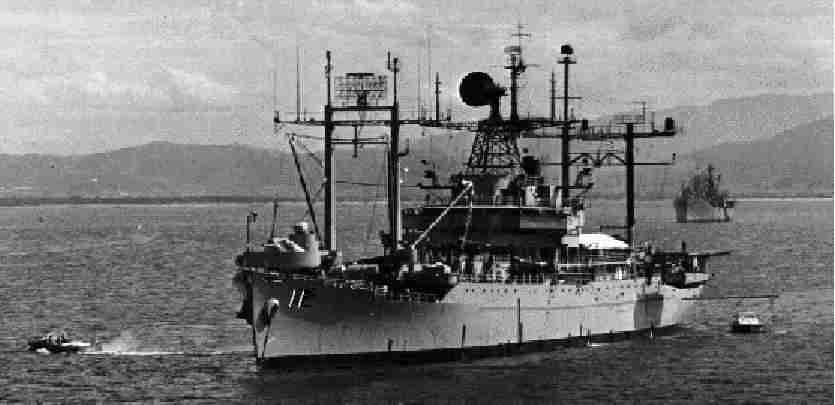
During the late 1960’s and early 1970’s I was aboard the USS Eldorado LCC 11 in the capacity of Electronic Warfare Operator, which at that time was part of the Radarman rating. While the Eldorado carried the Flag for Amphibious Operations Western Pacific most of our time was spent independent steaming to various locations where we did electronic surveillance. This was done separately by several groups including “spooks” (a name for intelligence types) of both the Navy and Marine corps, who gathered radio traffic when we were off shore of the various countries, including Viet Nam, Korea and China. My own job was less glamorous, consisting of plotting and recording the electronic signatures of coastal defense radars in these countries.
Occasionally this would involve very close passes of these countries, where we might “accidentally” enter their territorial waters for brief periods. Since I have no official knowledge otherwise I will assume these were accidents. It is significant, though that the Admiral would always leave the ship before these incidents and rejoin us at the next port.
One such incident was at the site of the current trouble, Hainan Island. We were passing from Viet Nam, enroute to Korea for landing exercises near the DMZ. As we passed Hainan I started working with a small crew plotting and recording their costal defense radars. These were low frequency, long-range jobs and when they “painted” us you could hear a long low “WOOOMMMMP” sound in the earphones of the equipment. These radars had to be plotted frequently as they were mounted on trucks and were moved frequently. As we approached a major naval port on the island I noticed that we stayed exactly at the limit of international waters, a tactic that always elicited an American response when the Russians did it to us off the American coast. Very soon the radarman on duty on the surface radar reported two surface contacts closing fast from the direction of the island and I immediately switched my equipment to the upper bandwidths, where the fire-control radars operated. Within a matter if minutes I caught a high pitched whine, sounding very much like a mosquito in the earphones and I knew they had us "in their sights". I reported this immediately to the Chief of the CIC (Combat Information Center). He reported the contacts to the officer there and to the captain on the bridge as I consulted my books and another sailor began recording the signals. I matched it in a very short time with the signature of a fire control radar for an Osa or Komar Class patrol boat. These patrol boats carried a particularly nasty missile called the “Styx” with a 99% kill rate and the Chief recommended General Quarters to the Captain. The alarm was sounded. “General Quarters, General Quarters! All hands man your battle stations! – This is NOT a drill!” The GQ alarm was blaring and men were rushing to stations in a sort of controlled chaos. My heart was beating wildly, I was one of two on the ship at that point who knew how grave the threat was.

The Captain asked the CIC for a threat assessment, wondering if we should turn and face them down. As our armament consisted of a single 5” gun forward and rail mounted machine guns, we were completely out gunned both in range and firepower. On being advised of this the Captain wisely ordered the ship to proceed away from the island at flank speed (about 13 knots) and then I plotted the boats closing on us, at about twice that. They were close enough that had they fired they could not miss, still they closed. Finally after some time (it seemed a very long time) they started falling back and soon they were out of range. Of course we had recorded every aspect of their response and I suspect that their presence had not been unexpected. As soon as the boats were determined to be returning to base, we resumed our northerly course, stood down from General Quarters and began recording their Coastal defenses again, which I found I could do from nearly twice the distance we had been doing it before.
This sort of cat-and-mouse, push-and-run behavior was typical of the cold war. It was nerve-wracking and sometimes dangerous but effective and apparently still going on, though the Cold War is counted over by most people.